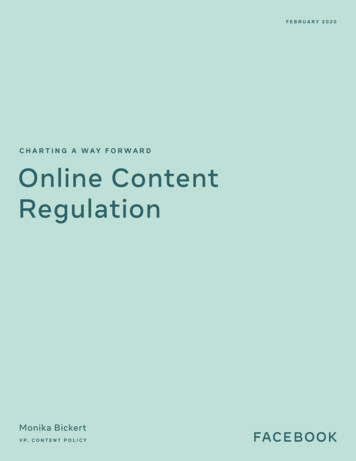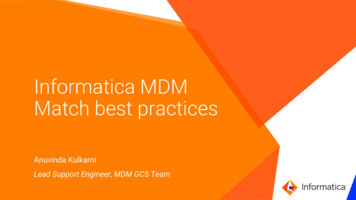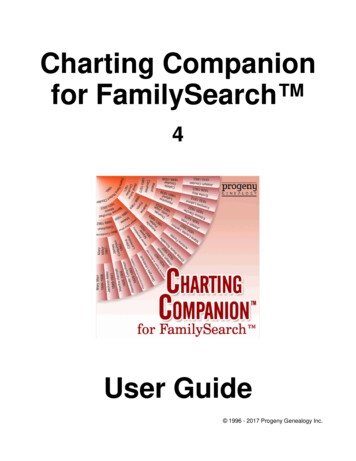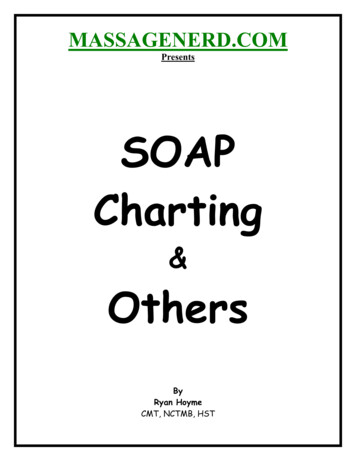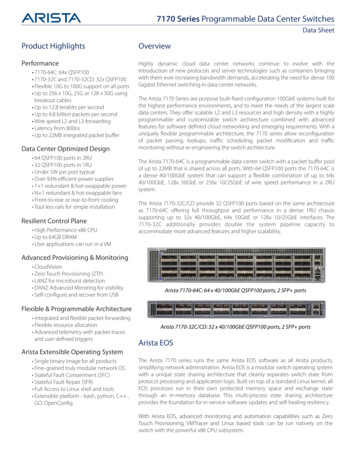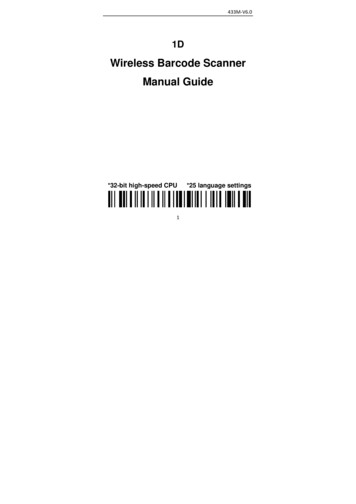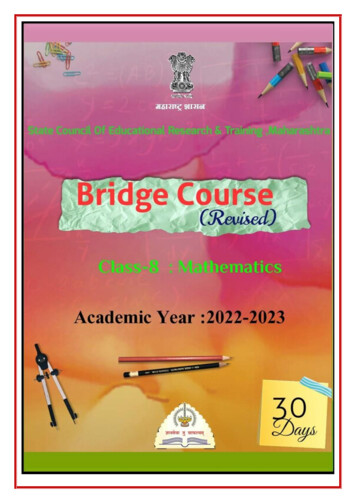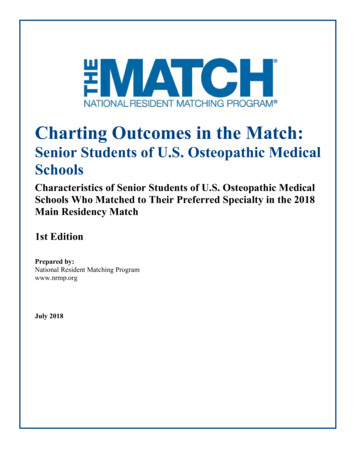
Transcription
Charting Outcomes in the Match:Senior Students of U.S. Osteopathic MedicalSchoolsCharacteristics of Senior Students of U.S. Osteopathic MedicalSchools Who Matched to Their Preferred Specialty in the 2018Main Residency Match1st EditionPrepared by:National Resident Matching Programwww.nrmp.orgJuly 2018
Questions about the contents of this publication may be directed to Mei Liang, Director of Research,National Resident Matching Program, (202) 400-2233 or datarequest@nrmp.org.Questions about the NRMP should be directed to Mona M. Signer, President and CEO, NationalResident Matching Program, (202) 400-2233 or admin@nrmp.org.Copyright 2018 National Resident Matching Program, 2121 K Street, NW, Suite 1000,Washington, DC 20037 USA. All rights reserved. Permission to use, copy and/or distribute anydocumentation and/or related images from this publication shall be expressly obtained from theNRMPNational Resident Matching Program, Charting Outcomes in the Match: Senior Students of U.S.Osteopathic Medical Schools, 2018. National Resident Matching Program, Washington, DC 2018.
2018Table of ContentsIntroduction . iiTables and Charts for All SpecialtiesChart 1. Active Applicants in the 2018 Main Residency Match . 2Table 1. Number of Applicants and Positions in the 2018 Main Residency Match . 3Chart 2. Ratio of Senior Students of U.S. Osteopathic Medical Schools Ranking Specialty First /Available Positions . 4Chart 3. Match Rates of Senior Students of U.S. Osteopathic Medical Schools . 5Table 2. Summary Statistics on Senior Students of U.S. Osteopathic Medical Schools . 6Chart 4. Median Number of Contiguous Ranks of Senior Students of U.S. Osteopathic Medical Schools . 7Chart 5. Mean Number of Different Specialties Ranked bySenior Students of U.S. Osteopathic Medical Schools . 8Chart 6. COMLEX-USA Level 1 Scores of Senior Students of U.S. Osteopathic Medical Schools . 9Chart 7. COMLEX-USA Level 2-CE Scores of Senior Students of U.S. Osteopathic Medical Schools . 10Chart 8. USMLE Step 1 Scores of Senior Students of U.S. Osteopathic Medical Schools . 11Chart 9. USMLE Step 2 CK Scores of Senior Students of U.S. Osteopathic Medical Schools . 12Chart 10. Mean Number of Research Experiences of Senior Students of U.S. Osteopathic Medical Schools . 13Chart 11. Mean Number of Abstracts, Presentations, and Publications ofSenior Students of U.S. Osteopathic Medical Schools . 14Chart 12. Mean Number of Work Experiences of Senior Students of U.S. Osteopathic Medical Schools . 15Chart 13. Mean Number of Volunteer Experiences of Senior Students of U.S. Osteopathic Medical Schools . 16Chart 14. Percentage of Senior Students of U.S. Osteopathic Medical SchoolsWho Have a Graduate Degree. 17Tables and Charts for Individual SpecialtiesAnesthesiology . 18Child Neurology. 28Dermatology . 38Diagnostic Radiology . 48Emergency Medicine . 58Family Medicine . 68General Surgery . 78Internal Medicine . 88Internal Medicine/Pediatrics . 98Interventional Radiology . 108Neurological Surgery . 118Neurology . 128Obstetrics and Gynecology . 138Orthopaedic Surgery . 148Pathology . 158Pediatrics . 168Physical Medicine and Rehabilitation . 178Psychiatry . 188Copyright 2018 NRMP. Reproduction prohibited without thewritten permission of the NRMP.iCharting Outcomes in the Match:Senior Students of U.S. Osteopathic Medical Schools, 2018
2018IntroductionBackgroundThe first edition of Charting Outcomes in the Match was published in August 2006 to document how applicant qualifications affect successin the Main Residency Match . The report was published biennially between 2007 and 2011 and was a collaboration of the NationalResident Matching Program (NRMP ) and the Association of American Medical Colleges (AAMC ). Match outcome data from theNRMP were combined with applicant characteristics from the AAMC’s Electronic Residency Application Service (ERAS ) and UnitedStates Medical Licensing Examination (USMLE ) scores from the AAMC data warehouse. In 2014, NRMP added a Professional Profilesection to its Match registration process to collect USMLE scores and other applicant characteristics and those have been used toindependently publish all subsequent Charting Outcomes in the Match reports.Prior to 2016, the Charting Outcomes in the Match report examined the Match success of only two applicant groups: senior students fromU.S. allopathic medical schools and independent applicants. Independent applicants included all applicant types other than U.S. seniors:previous graduates of U.S. allopathic medical schools, students/graduates of U.S. osteopathic medical schools, students/graduates of FifthPathway programs, students/graduates of Canadian medical schools, and U.S. citizen and non-U.S. citizen students/graduates ofinternational medical schools. Because independent applicants are a heterogeneous group, a decision was made in 2016 to report dataseparately for U.S. allopathic medical school seniors, students/graduates of U.S. osteopathic medical schools, U.S. citizenstudents/graduates of international medical schools, and non-U.S. citizen students/graduates of international medical schools.In 2018, upon requests from osteopathic medical schools, the report on osteopathic medical students/graduates was redesigned to includeonly senior students of osteopathic medical schools (U.S. osteopathic seniors), and this is the first of those reports. A U.S. osteopathicsenior is a fourth-year medical student in a U.S. osteopathic school of medicine accredited by the Commission on Osteopathic CollegeAccreditation (COCA) with a graduation date after July 1 in the year before the Match. Self-reported graduation dates were used toseparate senior students of osteopathic medical schools from graduates of osteopathic medical schools for the purposes of establishing thesample pool used in this report. Because the number of previous osteopathic medical school graduates is small, there is no separate reporton that group.Although the transition is underway for all graduate medical education programs to be accredited by the Accreditation Council forGraduate Medical Education (ACGME), U.S. osteopathic seniors can still participate in a Match sponsored by the American OsteopathicAssociation (AOA). Applicants who obtain positions in the AOA Match are automatically withdrawn from the NRMP so that they cannotmatch to concurrent year positions in the NRMP. The final AOA Match will culminate in March 2019.DataMatch success, specialty preference, and ranking information were collected through the Main Residency Match. Other applicantcharacteristics, including Comprehensive Osteopathic Medical Licensing Examinations (COMLEX-USA) Level 1 and Level 2-CognitiveEvaluation (CE) scores, USMLE Step 1 and Step 2 Clinical Knowledge (CK) scores, academic degrees, publications, research, and workand volunteer experiences, were self-reported through the Professional Profile section of the NRMP’s Applicant Registration Form for theMatch. To complete the form, applicants were asked to answer the questions as they did in their ERAS Common Application Form (CAF).Completion of the form was optional, and applicants who completed the form could consent or decline to participate in NRMP research.Data collection for the self-reported Professional Profile section was granted exemption by the Chesapeake (now Advarra) InstitutionalReview Board (IRB).To ensure that COMLEX-USA and USMLE scores were not misreported, the NRMP asked medical schools to verify the scores of theirsenior students. In 2018, the vast majority of the COMLEX-USA Level 1 (98%) and Level 2-CE (98%) scores and USMLE Step 1 (92%)and Step 2 CK (91%) scores used in this report were verified, corrected, or supplied by U.S. osteopathic medical schools. Because theself-reported scores are highly accurate, both verified and unverified scores were used to prepare this report: The intracorrelationcoefficient (ICC) between the self-reported scores and school-verified scores was 0.994 (99% CI [0.993, 0.994]) for COMLEX-USA Level1 scores, 0.993 (99% CI [0.993, 0.994]) for Level 2-CE scores, 0.947 (99% CI [0.941, 0.952]) for USMLE Step 1 scores, and 0.841 (99%CI [0.820, 0.859]) for Step 2 CK scores. Probability analyses of U.S. osteopathic seniors matching to a preferred specialty are based onCOMLEX-USA Level 1 scores of those who participated in the Match in 2016, 2017, and 2018. The 2016 COMLEX-USA scores wereprovided by the National Board of Osteopathic Medical Examiners (NBOME).A total of 4,275 senior students of osteopathic schools submitted certified rank order lists in the 2018 Main Residency Match. Afterexcluding the 9.8 percent who did not give consent to participate in NRMP research, 3,858 osteopathic applicants were included in thefinal dataset. Missing data were found in the number of COMLEX-USA Level 1 scores (0.5% missing), Level 2-CE scores (1.1%),USMLE Step 1 scores (39.3%), Step 2 CK scores (47.5%), research experiences (17.5%), number of abstracts, presentations, andCopyright 2018 NRMP. Reproduction prohibited without thewritten permission of the NRMP.iiCharting Outcomes in the Match:Senior Students of U.S. Osteopathic Medical Schools, 2018
2018Introduction (continued)publications (18.6%), number of work experiences (17.1%), number of volunteer experiences (16.8%), Ph.D. degree (8.3%), and othergraduate degree (7.8%).MethodsSpecialties that offered 50 or more positions and had at least 7 matched or unmatched U.S. osteopathic seniors preferring the specialty inthe 2018 Main Residency Match are included in this report. Although Otolaryngology, Plastic Surgery, Radiation Oncology, and VascularSurgery offered more than 50 positions, they are excluded from this report because the numbers of both matched and unmatched U.S.osteopathic seniors were smaller than 7. Transitional Year programs were excluded because they are not viewed as a specialty choice.Twelve measures are incorporated in this report: number of contiguous ranks in the preferred specialty, number of specialties ranked,COMLEX-USA Level 1 and Level 2 CE scores, USMLE Step 1 and Step 2 CK scores, numbers of research, work, and volunteerexperiences, number of abstracts, presentations, and publications, and Ph.D. and other graduate degrees. The probability of matching to apreferred specialty is calculated based on COMLEX-USA Level 1 scores and contiguous ranks.It is important to note that for purposes of this report, Match success is defined as a match to the specialty of the applicant’s first-rankedprogram, or "preferred specialty," because that is assumed to be the specialty of choice. Lack of success includes matching to anotherspecialty as well as failure to match at all. No distinction was made based on whether applicants matched to the first, second, third, orlower choice program.SummarySome general observations apply to all specialties in this report. U.S. osteopathic seniors who are successful in matching to their preferredspecialty are more likely to: Rank more programs within their preferred specialty Have higher COMLEX-USA Level 1 and Level 2-CE scores Have higher USMLE Step 1 and Step 2 CK scoresAlthough other measures seem to be related to Match success for some specialties, the relationships are not consistent enough to drawbroad conclusions across specialties. In addition, the data sources used for Charting Outcomes in the Match do not include other importantapplicant factors such as course evaluations, reference letters, and the Medical School Performance Evaluation (MSPE).Despite the fairly strong relationship between COMLEX-USA scores and Match success, the distributions of scores show that programdirectors consider other qualifications. A high score is not a guarantee of success, and a low score is not a bar to success. Data in this reportshow that some individuals with low scores are able to match to their preferred specialty, but a few people with high scores are notsuccessful. The data also are reassuring because they indicate that at least some programs do not employ an arbitrary cutoff or decline toconsider applicants with less than excellent test performance.The data in this report support the following straightforward advice one should give to an applicant: Rank all of the programs you really want, without regard to your estimate of your chances with those programs. Include a mix of both highly competitive and less competitive programs within your preferred specialty. Include all of the programs on your list where the program has expressed an interest in you and where you would accept a position. If you are applying to a competitive specialty and you want to have a residency position in the event you are unsuccessful in matchingto a program in your preferred specialty, also rank your most preferred programs in an alternate specialty. Include all of your qualifications in your application, but know that you do not have to have the highest COMLEX-USA scores, havepublications, or have participated in research projects to match successfully.Program directors and applicants will find the tables and charts for the specialty of their particular interest later in this report.For questions, comments or more information, please contact:Mei Liang, Director of ResearchNational Resident Matching Program2121 K Street, NW, Suite 1000Washington, DC 20037Tel: (202) 400-2233Email: datarequest@nrmp.orgCopyright 2018 NRMP. Reproduction prohibited without thewritten permission of the NRMP.iiiCharting Outcomes in the Match:Senior Students of U.S. Osteopathic Medical Schools, 2018
Tables and Charts for All SpecialtiesCopyright 2018 NRMP. Reproduction prohibited without thewritten permission of the NRMP.1Charting Outcomes in the Match:Senior Students of U.S. Osteopathic Medical Schools, 2018
Chart1Active Applicants in the 2018 Main Residency Matchby Applicant TypePreviousGraduates of U.S.Allopathic MedicalSchoolsSeniors of U.S.Osteopathic1,511Medical Schools4,275Seniors of U.S.AllopathicMedicalSchoolsPrevious Graduatesof U.S. OsteopathicMedical Schools18,818342U.S. CitizenStudents/Graduatesof InternationalMedical SchoolsStudents/Graduatesof Fifth PathwayPrograms5,0752Non-U.S. CitizenStudents/Graduatesof InternationalMedical SchoolsStudents/Graduatesof Canadian MedicalSchools7,06713Chart 1 shows the number of active applicants (applicants who submitted rank order lists of programs) byapplicant type in the 2018 Main Residency Match. A total of 37,103 active applicants participated in the 2018Main Residency Match including 4,617 senior students (4,275) and previous graduates (342) of U.S. osteopathicmedical schools. Senior students of osteopathic medical schools constituted 11.5 percent of all applicants in theMatch.Copyright 2018 NRMP. Reproduction prohibited without thewritten permission of the NRMP.2Charting Outcomes in the Match:Senior Students of U.S. Osteopathic Medical Schools, 2018
Table1Number of Applicants and Positions in the 2018 Main Residency Matchby Preferred Specialty*Preferred umber ofAll ApplicantsNumber ofAll ApplicantsPer PositionNumber of Osteopathic 9Child 1Diagnostic Radiology1,0991,2891.1711527142Emergency Medicine2,2782,6931.18457101558Family Medicine3,6294,4021.2161063673General Surgery1,3191,9551.486767134Internal Medicine7,91610,0321.2783064894Internal Medicine/Pediatrics3824391.1546854Interventional Radiology1362531.8631720Neurological tetrics and Gynecology2961,3361,7451.3115296248Orthopaedic 62,3831.5323790327Physical Medicine and RehabilitationPsychiatry* Preferred specialty is the specialty of the first-ranked program on an applicant's rank order list, excluding preliminary programs in specialties.Source: NRMP Data Warehouse.Table 1 provides a summary of the numbers of applicants and positions for specialties that offered at least 50 positions inthe Match and were preferred by at least 7 U.S. osteopathic seniors. For example, a total of 2,004 applicants preferredAnesthesiology (or ranked an Anesthesiology position first), among whom 296 were U.S. osteopathic seniors (267matched and 29 did not match to Anesthesiology). For each of the 1,840 Anesthesiology positions there were 1.09applicants who preferred the specialty.For those specialties offering both PGY-1 and PGY-2 positions (including Physician (R) positions), all position types havebeen combined.Copyright 2018 NRMP. Reproduction prohibited without thewritten permission of the NRMP.3Charting Outcomes in the Match:Senior Students of U.S. Osteopathic Medical Schools, 2018
Chart2Ratio of U.S. Osteopathic Seniors Ranking Specialty First / AvailablePositionsby Preferred Specialty2.5Osteopathic SeniorsAll Other mgnatooslogyEm tic .0Source: NRMP Data WarehouseChart 2 shows the ratios of all applicants and of U.S. osteopathic seniors to available positions in each specialty. For allspecialties displayed in the chart except Child Neurology, the total number of applicants preferring each specialty was morethan the number of available positions. Among all specialties in the chart, Interventional Radiology had the highest ratio ofall applicants per position; however, the highest ratio for U.S. osteopathic seniors was in Physical Medicine andRehabilitation.Copyright 2018 NRMP. Reproduction prohibited without thewritten permission of the NRMP.4Charting Outcomes in the Match:Senior Students of U.S. Osteopathic Medical Schools, 2018
Chart3Match Rates of U.S. Osteopathic SeniorsPercent Matched by Preferred ginyePeandiadtriRcsehabilitationPsychiatry0Source: NRMP Data WarehouseChart 3 shows the percentages of U.S. osteopathic seniors who matched to their preferred specialty. Overall, 82.6 percent ofU.S. osteopathic seniors matched to their preferred specialty, ranging from a high of 93.0 percent (Pathology) to a low of15.0 percent (Interventional Radiology).Copyright 2018 NRMP. Reproduction prohibited without thewritten permission of the NRMP.5Charting Outcomes in the Match:Senior Students of U.S. Osteopathic Medical Schools, 2018
Table2Summary Statistics on U.S. Osteopathic SeniorsAll Specialties CombinedMeasure1.2.3.4.5.6.7.8.9.10.11.12.Mean number of contiguous ranksMean number of distinct specialties rankedMean COMLEX-USA Level 1 scoreMean COMLEX-USA Level 2-CE scoreMean USMLE Step 1 scoreMean USMLE Step 2 CK scoreMean number of research experiencesMean number of abstracts, presentations, and publicationsMean number of work experiencesMean number of volunteer experiencesPercentage who have a Ph.D. degreePercentage who have another graduate degreeMatchedUnmatched(n 3,179)(n 5272202321.92.33.36.30.727.6Sources: NRMP Data WarehouseTable 2 provides summary statistics for all specialties by Match outcome on the 12 measures presented in this report.Data on each of these measures are displayed graphically by preferred specialty on the following pages. Only U.S.osteopathic seniors who gave consent to use their information in research are included in this table and the rest of thereport.Copyright 2018 NRMP. Reproduction prohibited without thewritten permission of the NRMP.6Charting Outcomes in the Match:Senior Students of U.S. Osteopathic Medical Schools, 2018
Median Number of Contiguous Ranks of U.S. Osteopathic SeniorsChart4by Preferred Specialty and Match StatusMatched121110Not Matched111110989109991099865444432243 ionPsychiatry04Source: NRMP Data WarehouseIn general, applicants are more likely to be successful if they rank more programs in their desired specialty. To quantify thisaspect of applicant behavior, we tallied the number of programs ranked in the first-choice specialty before a program inanother specialty appeared on the applicant's rank order list (contiguous ranks).Chart 4 displays the median number of contiguous ranks by preferred specialty for U.S. osteopathic seniors who did and didnot match to their preferred specialty. Both groups show variation across specialties. For almost all specialties, U.S.osteopathic seniors who matched to their preferred specialty had median contiguous rank lists that were longer than those whodid not match.The principal message of this chart is that applicants with longer rank order lists are more successful than those with shorterrank order lists. The NRMP has been recommending longer lists for many years, but some applicants apparently do not heedthe advice. Applicants who submit shorter rank order lists may do so because they find only a few programs willing toentertain their applications or because they cannot afford a large number of interview trips.Copyright 2018 NRMP. Reproduction prohibited without thewritten permission of the NRMP.7Charting Outcomes in the Match:Senior Students of U.S. Osteopathic Medical Schools, 2018
Chart5Mean Number of Different Specialties Ranked by U.S. Osteopathic Seniorsby Preferred Specialty and Match StatusMatchedNot didatRricehsabilitationPsychiatry0.0Source: NRMP Data WarehouseSome applicants are interested in a single specialty while others consider two or more. Chart 5 displays the average numberof different specialties ranked by preferred specialty and Match outcome. With the exception of Child Neurology andDiagnostic Radiology, U.S. osteopathic seniors who matched to their preferred specialty ranked fewer specialties than thosewho did not match.Copyright 2018 NRMP. Reproduction prohibited without thewritten permission of the NRMP.8Charting Outcomes in the Match:Senior Students of U.S. Osteopathic Medical Schools, 2018
Chart6COMLEX-USA Level 1 Scores of U.S. Osteopathic Seniorsby Preferred Specialty and Match StatusMatched750Not cehsabilitationPsychiatry400Source: NRMP Data WarehouseThe Comprehensive Osteopathic Medical Licensing Examinations (COMLEX-USA) are required for graduation from a U.S.osteopathic medical school. The COMLEX-USA examination series is designed to assess the osteopathic medical knowledgeand clinical skills considered essential for osteopathic generalist physicians to practice osteopathic medicine. COMLEX-USAis constructed in the context of clinical problem-solving that involves "Patient Presentations" and "Physician Tasks."COMLEX-USA Level 1 integrates the foundational and basic biomedical sciences of anatomy, behavioral science,biochemistry, genetics, microbiology, immunology, osteopathic principles, pathology, pharmacology, physiology and otherareas of medical knowledge as they are relevant to solving clinical problems and promoting and maintaining health inproviding osteopathic medical care to patients. Passing COMLEX-USA Level 1 is required for graduation with the Doctor ofOsteopathic Medicine (DO) degree in the United States, and COMLEX-USA is used for licensure for DOs in all 50 states.Overall, U.S. osteopathic seniors who matched to their preferred specialty had mean COMLEX-USA Level 1 scores of 547.1(s.d. 77.1) well above the 2018 minimum passing score of 400. COMLEX-USA Level 1 scores were available for 99percent of U.S. osteopathic seniors.Chart 6 displays the COMLEX-USA Level 1 scores for U.S. osteopathic seniors by specialty and match status. The horizontalbars are the median values for successful applicants and the vertical lines show the interquartile ranges (IQR, the range ofscores for applicants excluding the top and bottom quarters of the distribution). Unusually wide and unusually narrow IQRsoften indicate small sample sizes.For most specialties the IQRs of U.S. osteopathic seniors who matched to their preferred specialties are higher than those whodid not match. The IQRs of unmatched osteopathic seniors overlapped or surpassed that of the matched osteopathic seniorsfor Dermatology, Interventional Radiology, and Neurological Surgery, but the sample sizes for those specialties are small.Copyright 2018 NRMP. Reproduction prohibited without thewritten permission of the NRMP.9Charting Outcomes in the Match:Senior Students of U.S. Osteopathic Medical Schools, 2018
Chart7COMLEX-USA Level 2-CE Scores of U.S. Osteopathic Seniorsby Preferred Specialty and Match StatusMatchedNot riRcsehabilitationPsychiatry400Source: NRMP Data WarehouseThe COMLEX-USA Level 2-Cognitive Eva
senior is a fourth-year medical student in a U.S. osteopathic school of medicine accredited by the Commission on Osteopathic College Accreditation (COCA) with a graduation date after July 1 in the year before the Match. . U.S. osteopathic seniors can still participate in a Match sponsored by the American Osteopathic Association (AOA .


